Swinburne University PSY10002 Lab Report: Study Techniques Comparison
VerifiedAdded on 2022/11/13
|11
|2602
|441
Report
AI Summary
This psychology lab report investigates the effectiveness of massed versus distributed practice study techniques on student test performance at Swinburne University of Technology. The study involved 239 students who prepared for tests using either massed practice (cramming) or distributed practice (spaced repetition). The students were then assessed using fill-in-the-blank and multiple-choice tests. Results indicated that students utilizing distributed practice demonstrated superior overall performance compared to those using massed practice. A significant difference in means was observed in fill-in-the-blank tests, while multiple-choice tests showed no significant difference. The report concludes that distributed practice is a more worthwhile and effective study technique. The study also explores the theoretical underpinnings of these findings, including study-phase retrieval, consolidation, differential encoding, and contextual variability. Furthermore, the report discusses the implications of these findings, limitations, and the importance of adapting study techniques to the type of assessment.
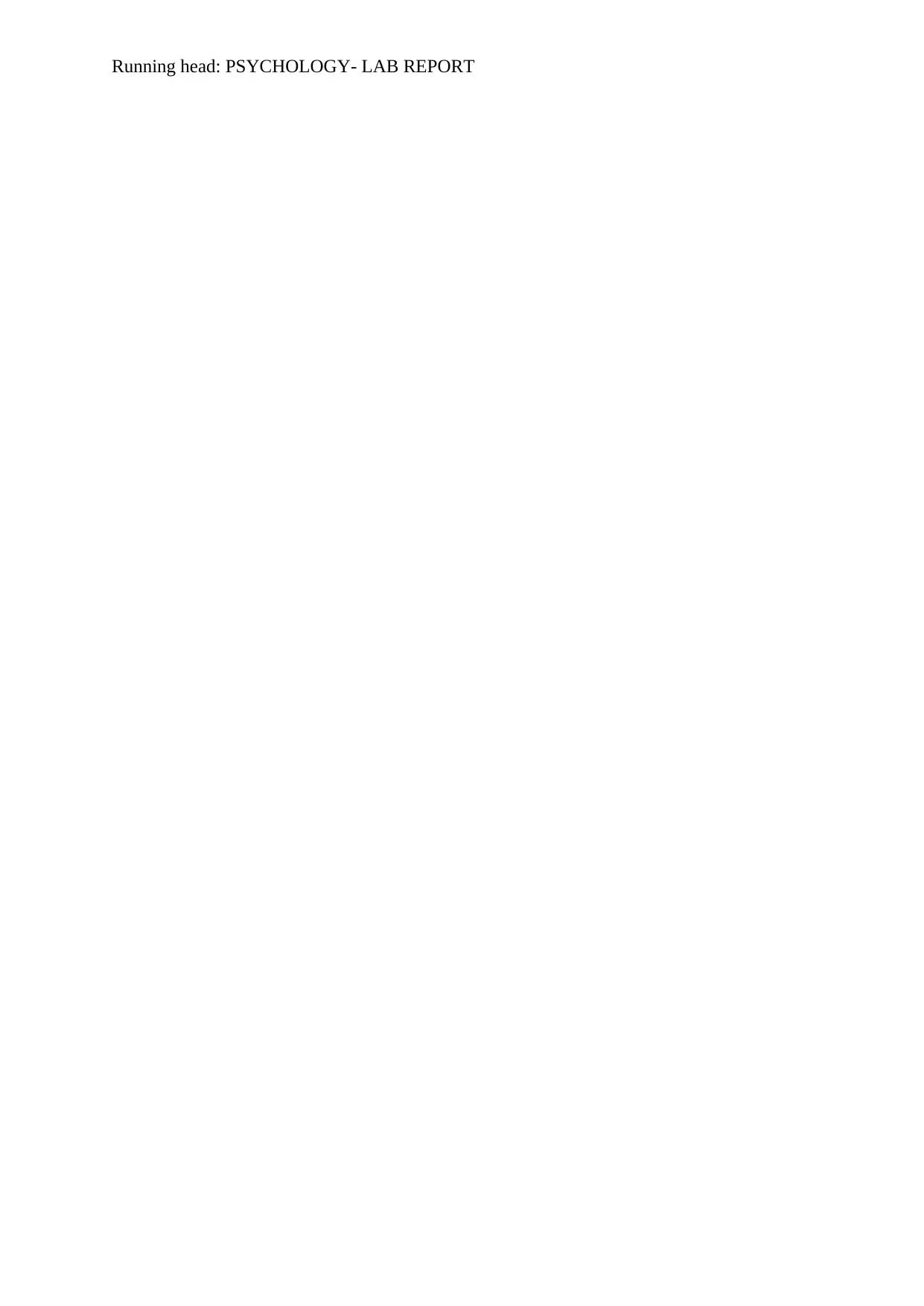
Running head: PSYCHOLOGY- LAB REPORT
Paraphrase This Document
Need a fresh take? Get an instant paraphrase of this document with our AI Paraphraser
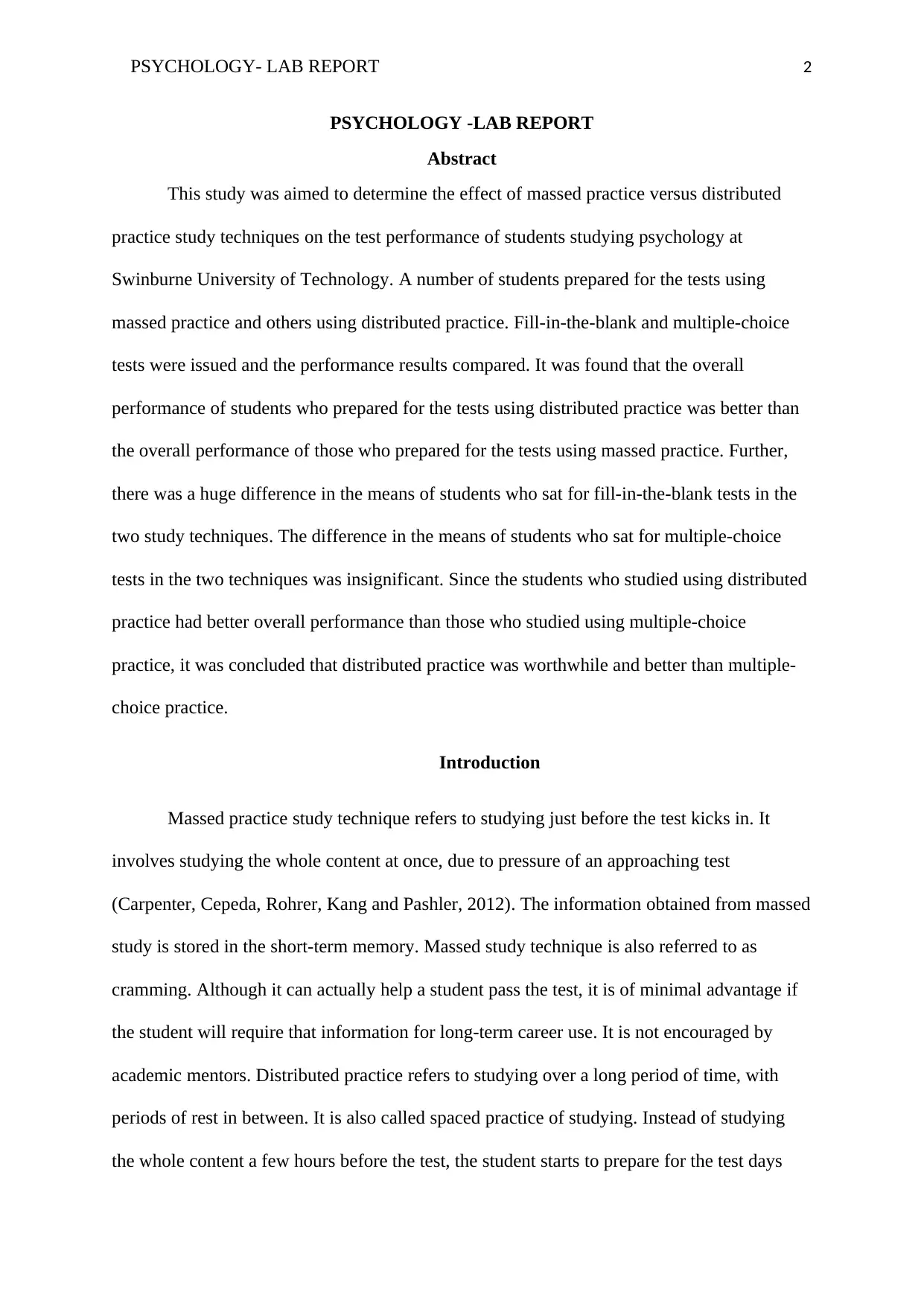
PSYCHOLOGY- LAB REPORT 2
PSYCHOLOGY -LAB REPORT
Abstract
This study was aimed to determine the effect of massed practice versus distributed
practice study techniques on the test performance of students studying psychology at
Swinburne University of Technology. A number of students prepared for the tests using
massed practice and others using distributed practice. Fill-in-the-blank and multiple-choice
tests were issued and the performance results compared. It was found that the overall
performance of students who prepared for the tests using distributed practice was better than
the overall performance of those who prepared for the tests using massed practice. Further,
there was a huge difference in the means of students who sat for fill-in-the-blank tests in the
two study techniques. The difference in the means of students who sat for multiple-choice
tests in the two techniques was insignificant. Since the students who studied using distributed
practice had better overall performance than those who studied using multiple-choice
practice, it was concluded that distributed practice was worthwhile and better than multiple-
choice practice.
Introduction
Massed practice study technique refers to studying just before the test kicks in. It
involves studying the whole content at once, due to pressure of an approaching test
(Carpenter, Cepeda, Rohrer, Kang and Pashler, 2012). The information obtained from massed
study is stored in the short-term memory. Massed study technique is also referred to as
cramming. Although it can actually help a student pass the test, it is of minimal advantage if
the student will require that information for long-term career use. It is not encouraged by
academic mentors. Distributed practice refers to studying over a long period of time, with
periods of rest in between. It is also called spaced practice of studying. Instead of studying
the whole content a few hours before the test, the student starts to prepare for the test days
PSYCHOLOGY -LAB REPORT
Abstract
This study was aimed to determine the effect of massed practice versus distributed
practice study techniques on the test performance of students studying psychology at
Swinburne University of Technology. A number of students prepared for the tests using
massed practice and others using distributed practice. Fill-in-the-blank and multiple-choice
tests were issued and the performance results compared. It was found that the overall
performance of students who prepared for the tests using distributed practice was better than
the overall performance of those who prepared for the tests using massed practice. Further,
there was a huge difference in the means of students who sat for fill-in-the-blank tests in the
two study techniques. The difference in the means of students who sat for multiple-choice
tests in the two techniques was insignificant. Since the students who studied using distributed
practice had better overall performance than those who studied using multiple-choice
practice, it was concluded that distributed practice was worthwhile and better than multiple-
choice practice.
Introduction
Massed practice study technique refers to studying just before the test kicks in. It
involves studying the whole content at once, due to pressure of an approaching test
(Carpenter, Cepeda, Rohrer, Kang and Pashler, 2012). The information obtained from massed
study is stored in the short-term memory. Massed study technique is also referred to as
cramming. Although it can actually help a student pass the test, it is of minimal advantage if
the student will require that information for long-term career use. It is not encouraged by
academic mentors. Distributed practice refers to studying over a long period of time, with
periods of rest in between. It is also called spaced practice of studying. Instead of studying
the whole content a few hours before the test, the student starts to prepare for the test days
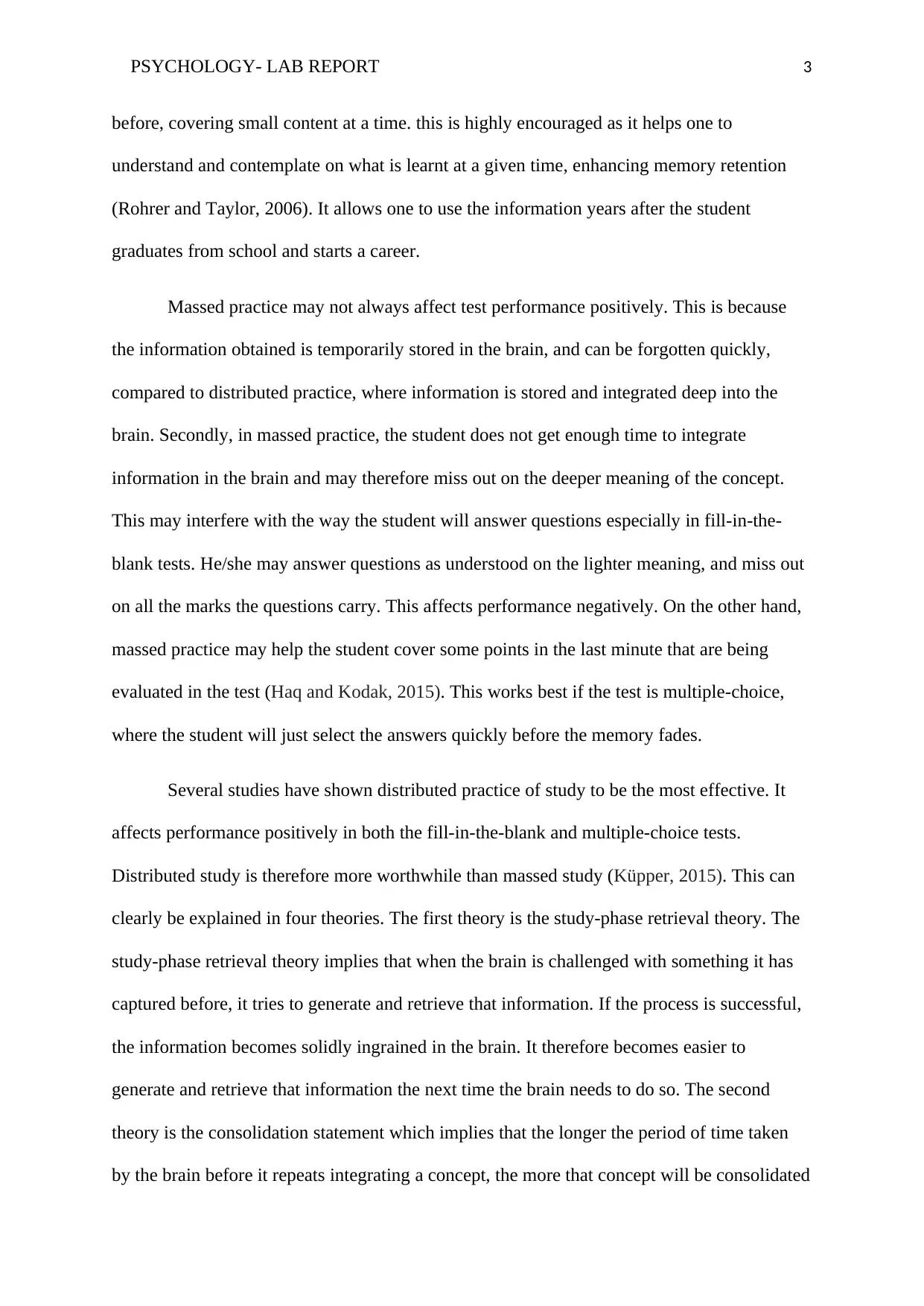
PSYCHOLOGY- LAB REPORT 3
before, covering small content at a time. this is highly encouraged as it helps one to
understand and contemplate on what is learnt at a given time, enhancing memory retention
(Rohrer and Taylor, 2006). It allows one to use the information years after the student
graduates from school and starts a career.
Massed practice may not always affect test performance positively. This is because
the information obtained is temporarily stored in the brain, and can be forgotten quickly,
compared to distributed practice, where information is stored and integrated deep into the
brain. Secondly, in massed practice, the student does not get enough time to integrate
information in the brain and may therefore miss out on the deeper meaning of the concept.
This may interfere with the way the student will answer questions especially in fill-in-the-
blank tests. He/she may answer questions as understood on the lighter meaning, and miss out
on all the marks the questions carry. This affects performance negatively. On the other hand,
massed practice may help the student cover some points in the last minute that are being
evaluated in the test (Haq and Kodak, 2015). This works best if the test is multiple-choice,
where the student will just select the answers quickly before the memory fades.
Several studies have shown distributed practice of study to be the most effective. It
affects performance positively in both the fill-in-the-blank and multiple-choice tests.
Distributed study is therefore more worthwhile than massed study (Küpper, 2015). This can
clearly be explained in four theories. The first theory is the study-phase retrieval theory. The
study-phase retrieval theory implies that when the brain is challenged with something it has
captured before, it tries to generate and retrieve that information. If the process is successful,
the information becomes solidly ingrained in the brain. It therefore becomes easier to
generate and retrieve that information the next time the brain needs to do so. The second
theory is the consolidation statement which implies that the longer the period of time taken
by the brain before it repeats integrating a concept, the more that concept will be consolidated
before, covering small content at a time. this is highly encouraged as it helps one to
understand and contemplate on what is learnt at a given time, enhancing memory retention
(Rohrer and Taylor, 2006). It allows one to use the information years after the student
graduates from school and starts a career.
Massed practice may not always affect test performance positively. This is because
the information obtained is temporarily stored in the brain, and can be forgotten quickly,
compared to distributed practice, where information is stored and integrated deep into the
brain. Secondly, in massed practice, the student does not get enough time to integrate
information in the brain and may therefore miss out on the deeper meaning of the concept.
This may interfere with the way the student will answer questions especially in fill-in-the-
blank tests. He/she may answer questions as understood on the lighter meaning, and miss out
on all the marks the questions carry. This affects performance negatively. On the other hand,
massed practice may help the student cover some points in the last minute that are being
evaluated in the test (Haq and Kodak, 2015). This works best if the test is multiple-choice,
where the student will just select the answers quickly before the memory fades.
Several studies have shown distributed practice of study to be the most effective. It
affects performance positively in both the fill-in-the-blank and multiple-choice tests.
Distributed study is therefore more worthwhile than massed study (Küpper, 2015). This can
clearly be explained in four theories. The first theory is the study-phase retrieval theory. The
study-phase retrieval theory implies that when the brain is challenged with something it has
captured before, it tries to generate and retrieve that information. If the process is successful,
the information becomes solidly ingrained in the brain. It therefore becomes easier to
generate and retrieve that information the next time the brain needs to do so. The second
theory is the consolidation statement which implies that the longer the period of time taken
by the brain before it repeats integrating a concept, the more that concept will be consolidated
⊘ This is a preview!⊘
Do you want full access?
Subscribe today to unlock all pages.

Trusted by 1+ million students worldwide
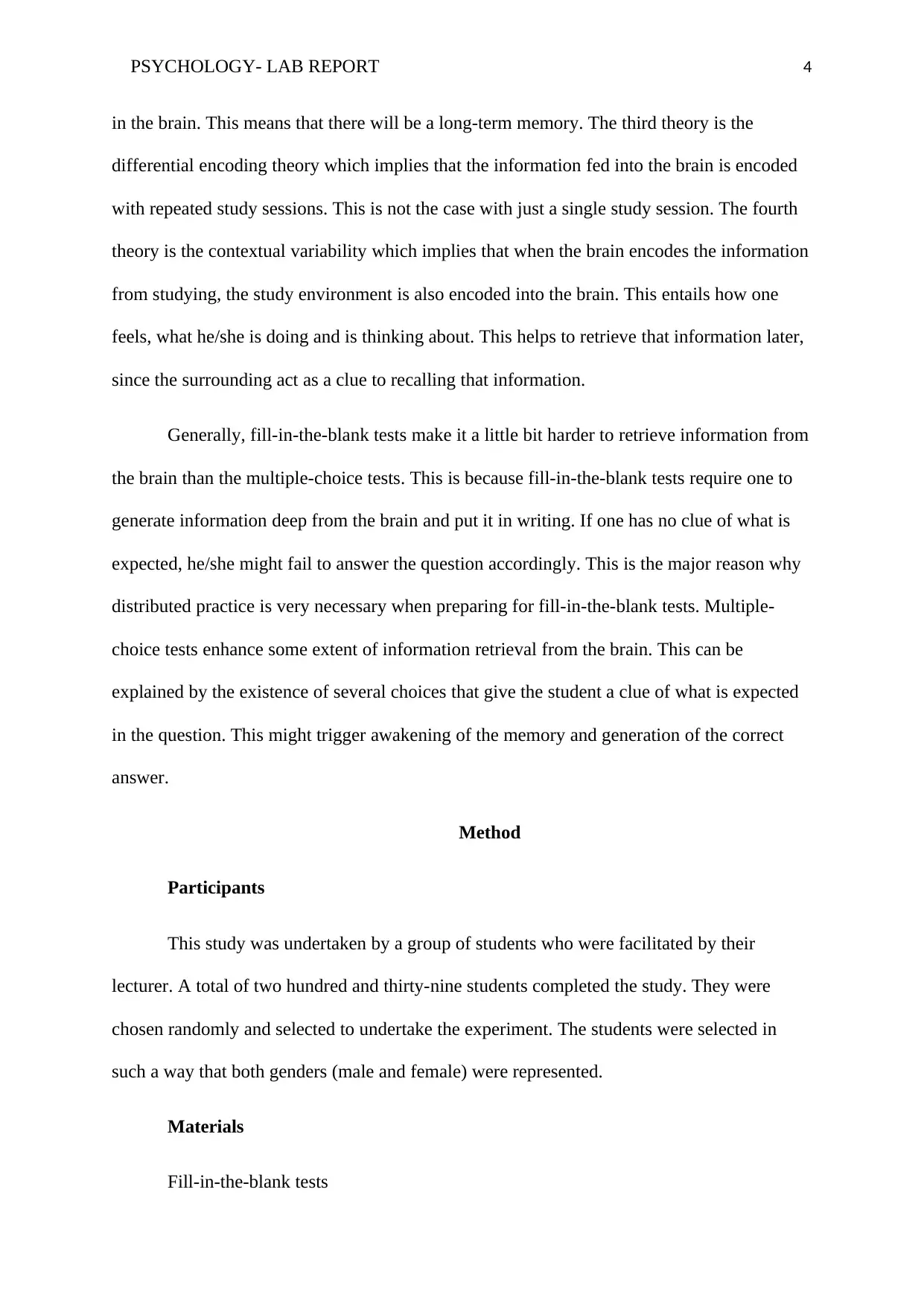
PSYCHOLOGY- LAB REPORT 4
in the brain. This means that there will be a long-term memory. The third theory is the
differential encoding theory which implies that the information fed into the brain is encoded
with repeated study sessions. This is not the case with just a single study session. The fourth
theory is the contextual variability which implies that when the brain encodes the information
from studying, the study environment is also encoded into the brain. This entails how one
feels, what he/she is doing and is thinking about. This helps to retrieve that information later,
since the surrounding act as a clue to recalling that information.
Generally, fill-in-the-blank tests make it a little bit harder to retrieve information from
the brain than the multiple-choice tests. This is because fill-in-the-blank tests require one to
generate information deep from the brain and put it in writing. If one has no clue of what is
expected, he/she might fail to answer the question accordingly. This is the major reason why
distributed practice is very necessary when preparing for fill-in-the-blank tests. Multiple-
choice tests enhance some extent of information retrieval from the brain. This can be
explained by the existence of several choices that give the student a clue of what is expected
in the question. This might trigger awakening of the memory and generation of the correct
answer.
Method
Participants
This study was undertaken by a group of students who were facilitated by their
lecturer. A total of two hundred and thirty-nine students completed the study. They were
chosen randomly and selected to undertake the experiment. The students were selected in
such a way that both genders (male and female) were represented.
Materials
Fill-in-the-blank tests
in the brain. This means that there will be a long-term memory. The third theory is the
differential encoding theory which implies that the information fed into the brain is encoded
with repeated study sessions. This is not the case with just a single study session. The fourth
theory is the contextual variability which implies that when the brain encodes the information
from studying, the study environment is also encoded into the brain. This entails how one
feels, what he/she is doing and is thinking about. This helps to retrieve that information later,
since the surrounding act as a clue to recalling that information.
Generally, fill-in-the-blank tests make it a little bit harder to retrieve information from
the brain than the multiple-choice tests. This is because fill-in-the-blank tests require one to
generate information deep from the brain and put it in writing. If one has no clue of what is
expected, he/she might fail to answer the question accordingly. This is the major reason why
distributed practice is very necessary when preparing for fill-in-the-blank tests. Multiple-
choice tests enhance some extent of information retrieval from the brain. This can be
explained by the existence of several choices that give the student a clue of what is expected
in the question. This might trigger awakening of the memory and generation of the correct
answer.
Method
Participants
This study was undertaken by a group of students who were facilitated by their
lecturer. A total of two hundred and thirty-nine students completed the study. They were
chosen randomly and selected to undertake the experiment. The students were selected in
such a way that both genders (male and female) were represented.
Materials
Fill-in-the-blank tests
Paraphrase This Document
Need a fresh take? Get an instant paraphrase of this document with our AI Paraphraser
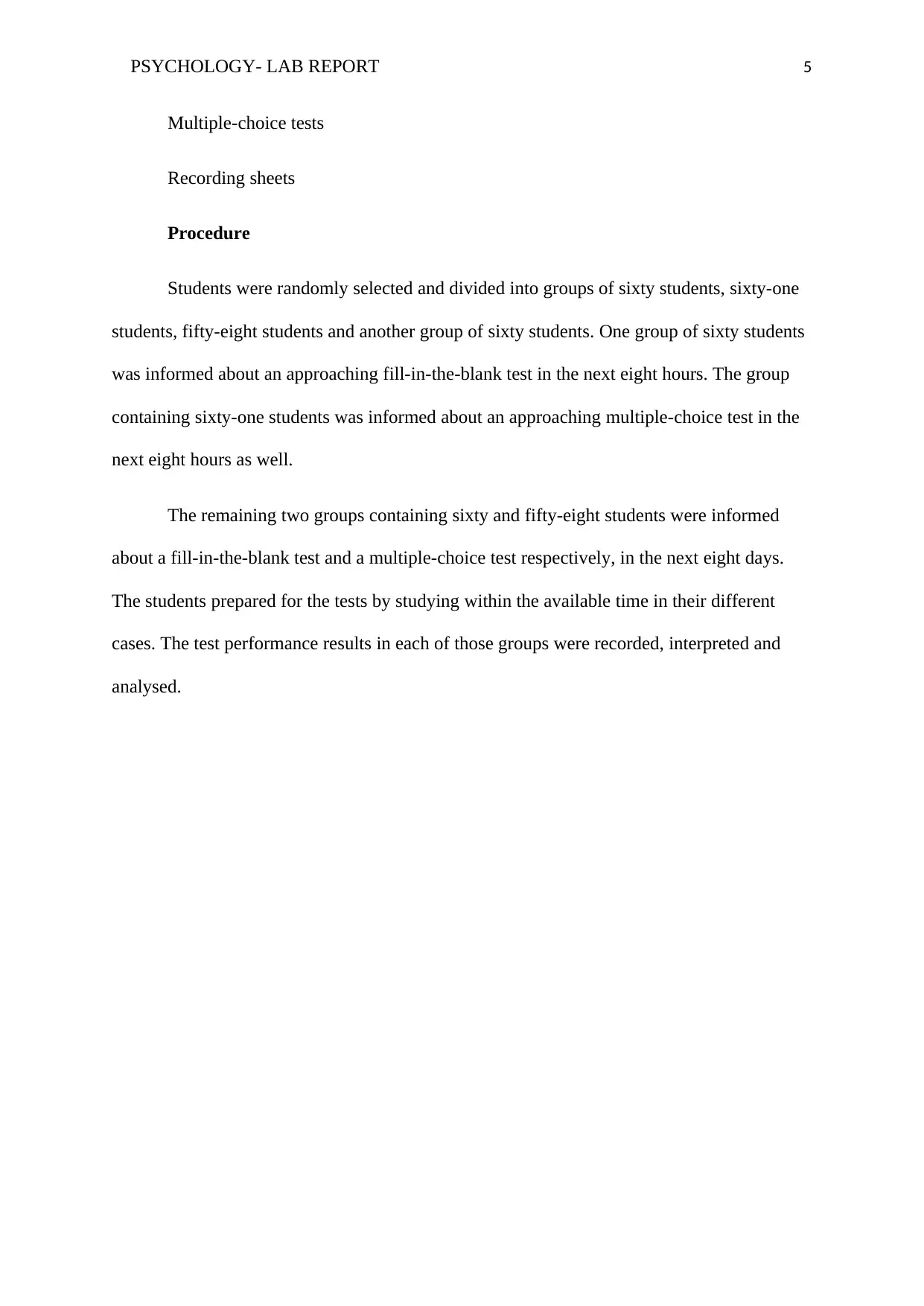
PSYCHOLOGY- LAB REPORT 5
Multiple-choice tests
Recording sheets
Procedure
Students were randomly selected and divided into groups of sixty students, sixty-one
students, fifty-eight students and another group of sixty students. One group of sixty students
was informed about an approaching fill-in-the-blank test in the next eight hours. The group
containing sixty-one students was informed about an approaching multiple-choice test in the
next eight hours as well.
The remaining two groups containing sixty and fifty-eight students were informed
about a fill-in-the-blank test and a multiple-choice test respectively, in the next eight days.
The students prepared for the tests by studying within the available time in their different
cases. The test performance results in each of those groups were recorded, interpreted and
analysed.
Multiple-choice tests
Recording sheets
Procedure
Students were randomly selected and divided into groups of sixty students, sixty-one
students, fifty-eight students and another group of sixty students. One group of sixty students
was informed about an approaching fill-in-the-blank test in the next eight hours. The group
containing sixty-one students was informed about an approaching multiple-choice test in the
next eight hours as well.
The remaining two groups containing sixty and fifty-eight students were informed
about a fill-in-the-blank test and a multiple-choice test respectively, in the next eight days.
The students prepared for the tests by studying within the available time in their different
cases. The test performance results in each of those groups were recorded, interpreted and
analysed.
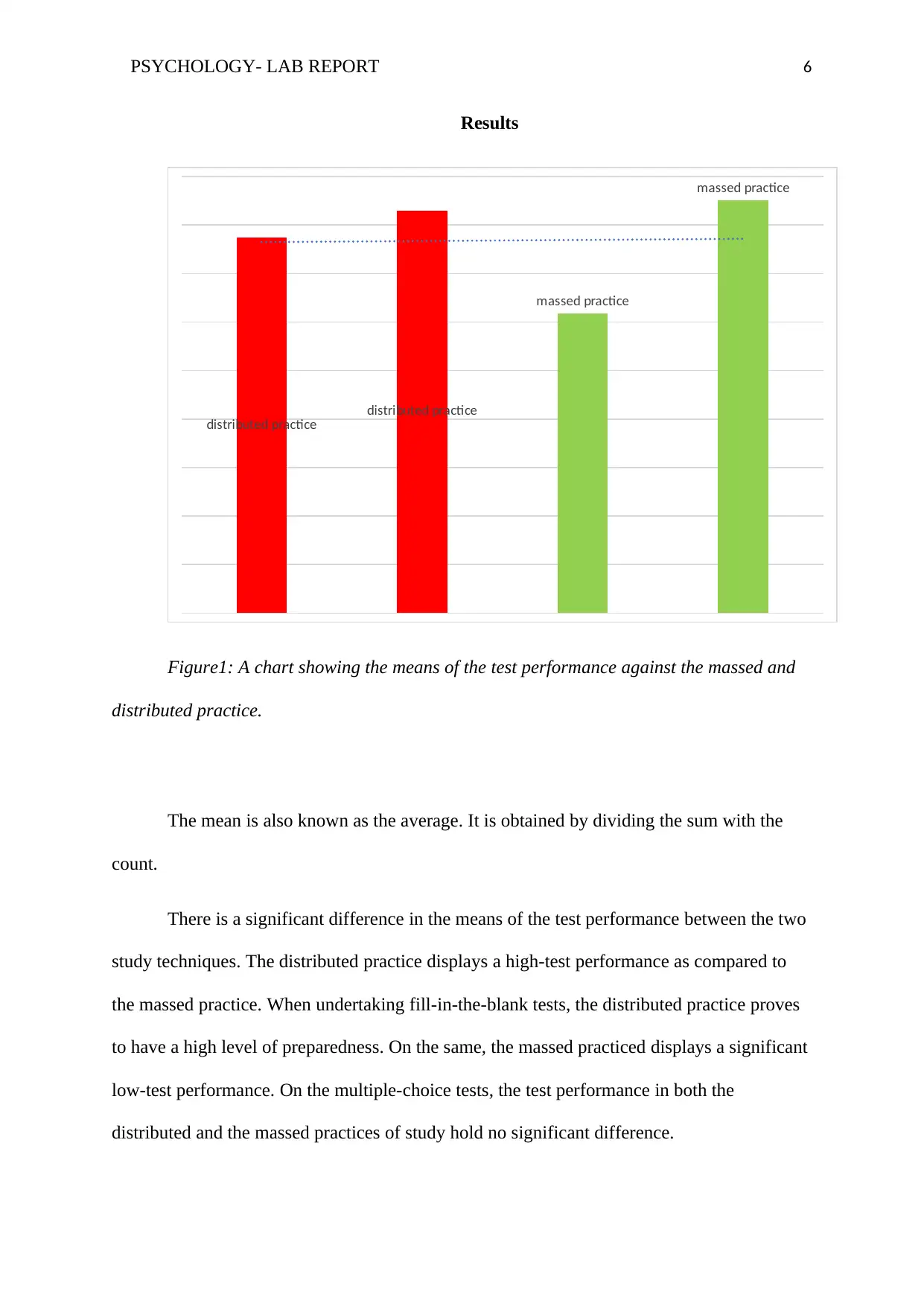
PSYCHOLOGY- LAB REPORT 6
Results
distributed practice distributed practice
massed practice
massed practice
Figure1: A chart showing the means of the test performance against the massed and
distributed practice.
The mean is also known as the average. It is obtained by dividing the sum with the
count.
There is a significant difference in the means of the test performance between the two
study techniques. The distributed practice displays a high-test performance as compared to
the massed practice. When undertaking fill-in-the-blank tests, the distributed practice proves
to have a high level of preparedness. On the same, the massed practiced displays a significant
low-test performance. On the multiple-choice tests, the test performance in both the
distributed and the massed practices of study hold no significant difference.
Results
distributed practice distributed practice
massed practice
massed practice
Figure1: A chart showing the means of the test performance against the massed and
distributed practice.
The mean is also known as the average. It is obtained by dividing the sum with the
count.
There is a significant difference in the means of the test performance between the two
study techniques. The distributed practice displays a high-test performance as compared to
the massed practice. When undertaking fill-in-the-blank tests, the distributed practice proves
to have a high level of preparedness. On the same, the massed practiced displays a significant
low-test performance. On the multiple-choice tests, the test performance in both the
distributed and the massed practices of study hold no significant difference.
⊘ This is a preview!⊘
Do you want full access?
Subscribe today to unlock all pages.

Trusted by 1+ million students worldwide
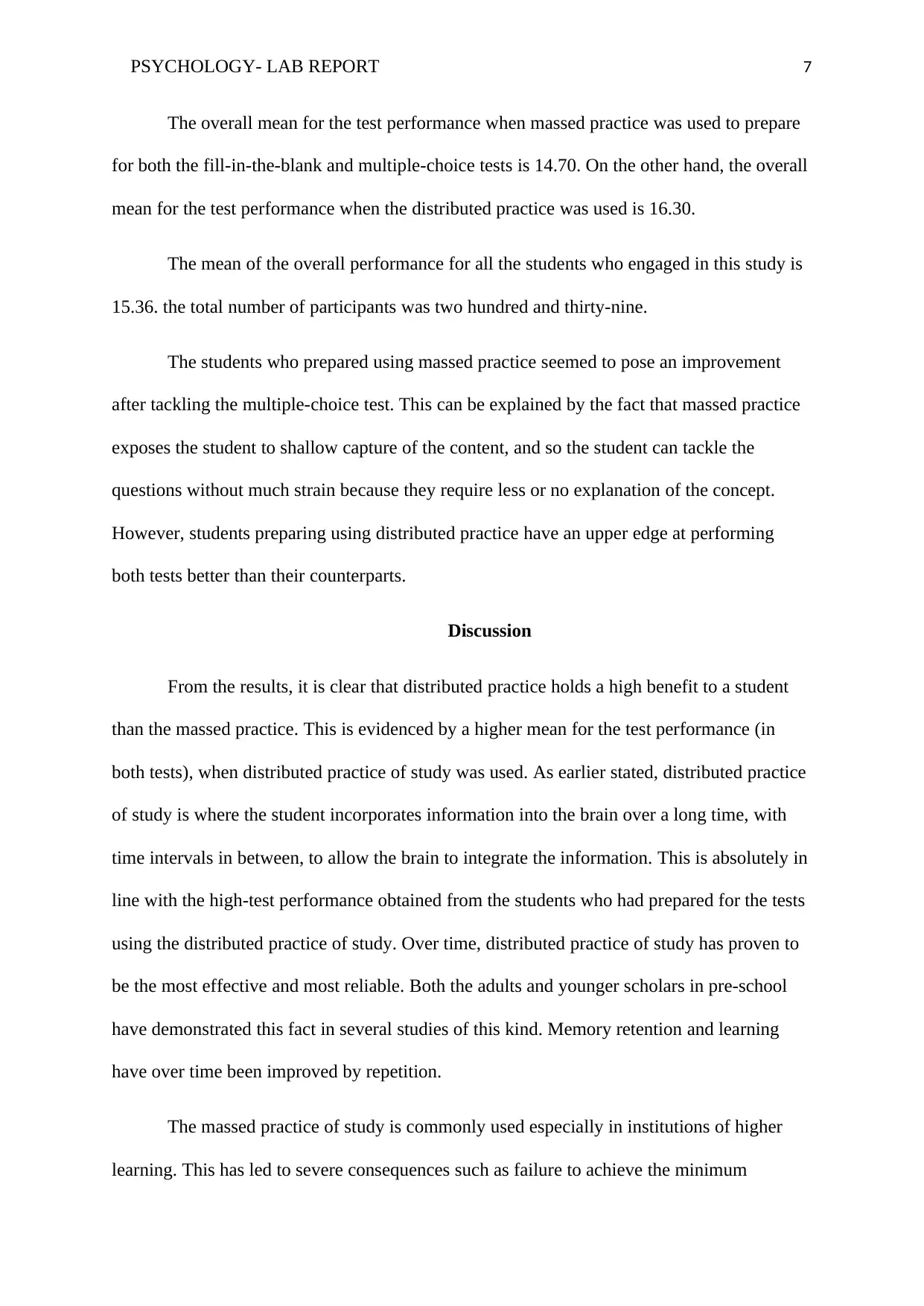
PSYCHOLOGY- LAB REPORT 7
The overall mean for the test performance when massed practice was used to prepare
for both the fill-in-the-blank and multiple-choice tests is 14.70. On the other hand, the overall
mean for the test performance when the distributed practice was used is 16.30.
The mean of the overall performance for all the students who engaged in this study is
15.36. the total number of participants was two hundred and thirty-nine.
The students who prepared using massed practice seemed to pose an improvement
after tackling the multiple-choice test. This can be explained by the fact that massed practice
exposes the student to shallow capture of the content, and so the student can tackle the
questions without much strain because they require less or no explanation of the concept.
However, students preparing using distributed practice have an upper edge at performing
both tests better than their counterparts.
Discussion
From the results, it is clear that distributed practice holds a high benefit to a student
than the massed practice. This is evidenced by a higher mean for the test performance (in
both tests), when distributed practice of study was used. As earlier stated, distributed practice
of study is where the student incorporates information into the brain over a long time, with
time intervals in between, to allow the brain to integrate the information. This is absolutely in
line with the high-test performance obtained from the students who had prepared for the tests
using the distributed practice of study. Over time, distributed practice of study has proven to
be the most effective and most reliable. Both the adults and younger scholars in pre-school
have demonstrated this fact in several studies of this kind. Memory retention and learning
have over time been improved by repetition.
The massed practice of study is commonly used especially in institutions of higher
learning. This has led to severe consequences such as failure to achieve the minimum
The overall mean for the test performance when massed practice was used to prepare
for both the fill-in-the-blank and multiple-choice tests is 14.70. On the other hand, the overall
mean for the test performance when the distributed practice was used is 16.30.
The mean of the overall performance for all the students who engaged in this study is
15.36. the total number of participants was two hundred and thirty-nine.
The students who prepared using massed practice seemed to pose an improvement
after tackling the multiple-choice test. This can be explained by the fact that massed practice
exposes the student to shallow capture of the content, and so the student can tackle the
questions without much strain because they require less or no explanation of the concept.
However, students preparing using distributed practice have an upper edge at performing
both tests better than their counterparts.
Discussion
From the results, it is clear that distributed practice holds a high benefit to a student
than the massed practice. This is evidenced by a higher mean for the test performance (in
both tests), when distributed practice of study was used. As earlier stated, distributed practice
of study is where the student incorporates information into the brain over a long time, with
time intervals in between, to allow the brain to integrate the information. This is absolutely in
line with the high-test performance obtained from the students who had prepared for the tests
using the distributed practice of study. Over time, distributed practice of study has proven to
be the most effective and most reliable. Both the adults and younger scholars in pre-school
have demonstrated this fact in several studies of this kind. Memory retention and learning
have over time been improved by repetition.
The massed practice of study is commonly used especially in institutions of higher
learning. This has led to severe consequences such as failure to achieve the minimum
Paraphrase This Document
Need a fresh take? Get an instant paraphrase of this document with our AI Paraphraser
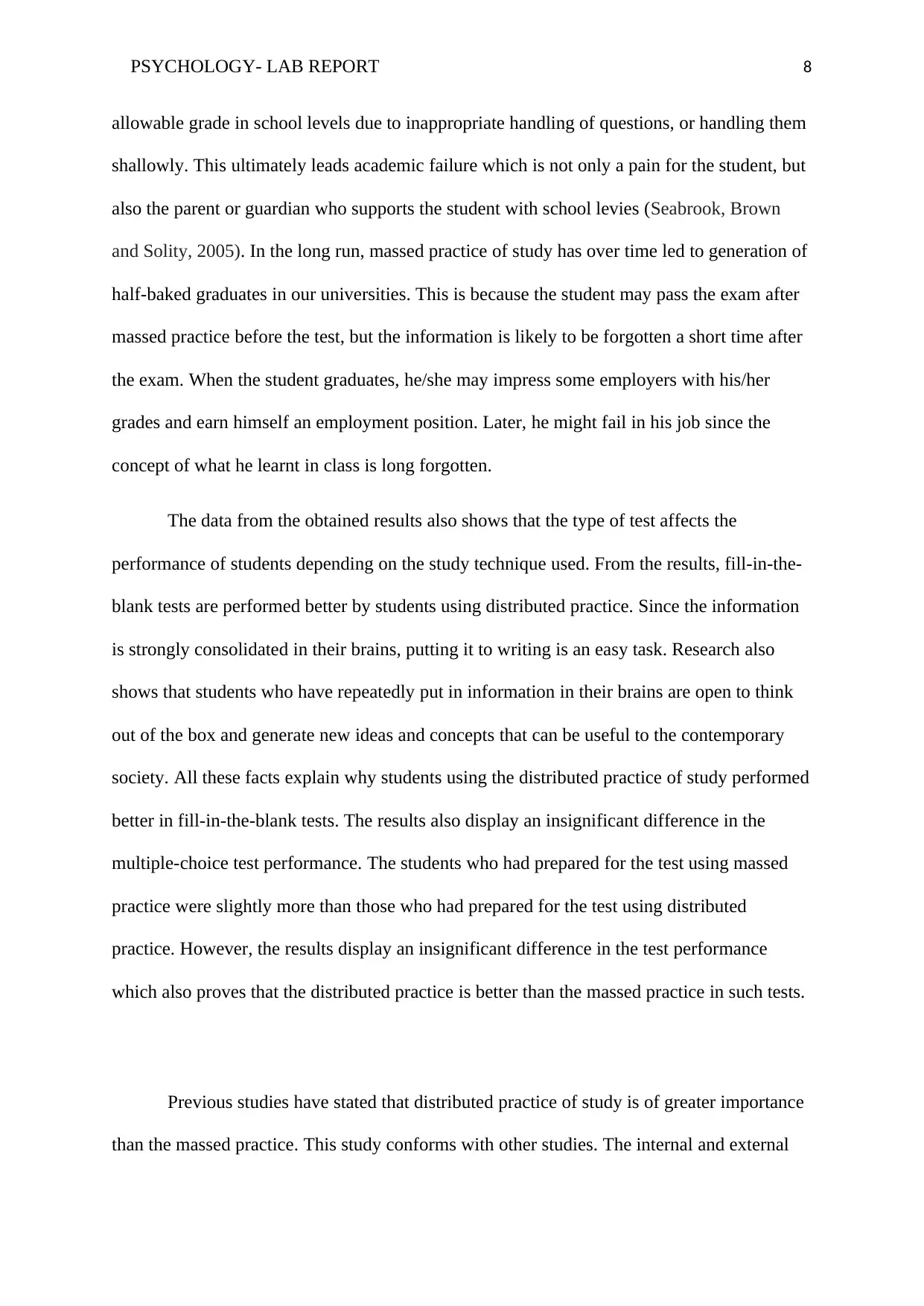
PSYCHOLOGY- LAB REPORT 8
allowable grade in school levels due to inappropriate handling of questions, or handling them
shallowly. This ultimately leads academic failure which is not only a pain for the student, but
also the parent or guardian who supports the student with school levies (Seabrook, Brown
and Solity, 2005). In the long run, massed practice of study has over time led to generation of
half-baked graduates in our universities. This is because the student may pass the exam after
massed practice before the test, but the information is likely to be forgotten a short time after
the exam. When the student graduates, he/she may impress some employers with his/her
grades and earn himself an employment position. Later, he might fail in his job since the
concept of what he learnt in class is long forgotten.
The data from the obtained results also shows that the type of test affects the
performance of students depending on the study technique used. From the results, fill-in-the-
blank tests are performed better by students using distributed practice. Since the information
is strongly consolidated in their brains, putting it to writing is an easy task. Research also
shows that students who have repeatedly put in information in their brains are open to think
out of the box and generate new ideas and concepts that can be useful to the contemporary
society. All these facts explain why students using the distributed practice of study performed
better in fill-in-the-blank tests. The results also display an insignificant difference in the
multiple-choice test performance. The students who had prepared for the test using massed
practice were slightly more than those who had prepared for the test using distributed
practice. However, the results display an insignificant difference in the test performance
which also proves that the distributed practice is better than the massed practice in such tests.
Previous studies have stated that distributed practice of study is of greater importance
than the massed practice. This study conforms with other studies. The internal and external
allowable grade in school levels due to inappropriate handling of questions, or handling them
shallowly. This ultimately leads academic failure which is not only a pain for the student, but
also the parent or guardian who supports the student with school levies (Seabrook, Brown
and Solity, 2005). In the long run, massed practice of study has over time led to generation of
half-baked graduates in our universities. This is because the student may pass the exam after
massed practice before the test, but the information is likely to be forgotten a short time after
the exam. When the student graduates, he/she may impress some employers with his/her
grades and earn himself an employment position. Later, he might fail in his job since the
concept of what he learnt in class is long forgotten.
The data from the obtained results also shows that the type of test affects the
performance of students depending on the study technique used. From the results, fill-in-the-
blank tests are performed better by students using distributed practice. Since the information
is strongly consolidated in their brains, putting it to writing is an easy task. Research also
shows that students who have repeatedly put in information in their brains are open to think
out of the box and generate new ideas and concepts that can be useful to the contemporary
society. All these facts explain why students using the distributed practice of study performed
better in fill-in-the-blank tests. The results also display an insignificant difference in the
multiple-choice test performance. The students who had prepared for the test using massed
practice were slightly more than those who had prepared for the test using distributed
practice. However, the results display an insignificant difference in the test performance
which also proves that the distributed practice is better than the massed practice in such tests.
Previous studies have stated that distributed practice of study is of greater importance
than the massed practice. This study conforms with other studies. The internal and external
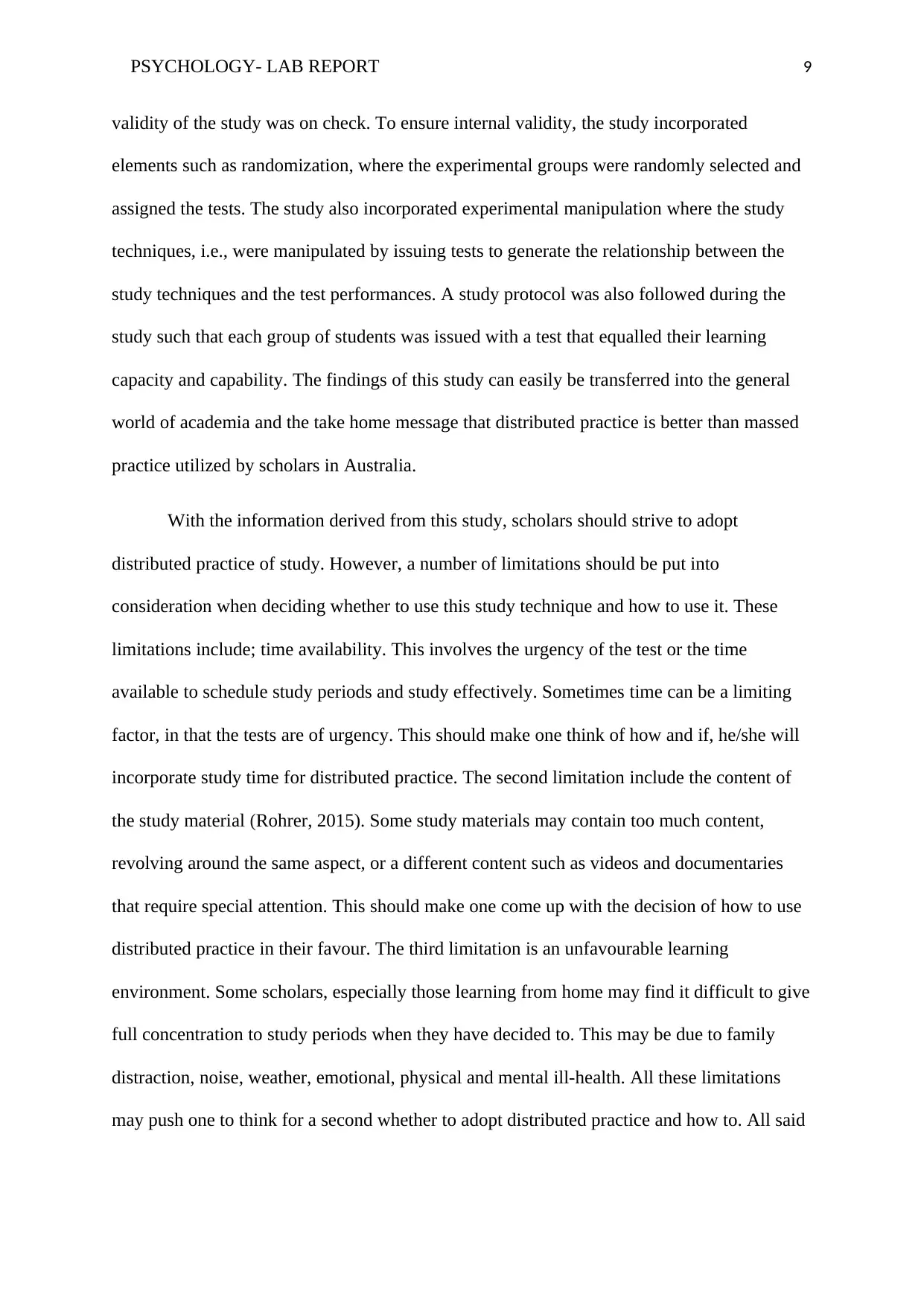
PSYCHOLOGY- LAB REPORT 9
validity of the study was on check. To ensure internal validity, the study incorporated
elements such as randomization, where the experimental groups were randomly selected and
assigned the tests. The study also incorporated experimental manipulation where the study
techniques, i.e., were manipulated by issuing tests to generate the relationship between the
study techniques and the test performances. A study protocol was also followed during the
study such that each group of students was issued with a test that equalled their learning
capacity and capability. The findings of this study can easily be transferred into the general
world of academia and the take home message that distributed practice is better than massed
practice utilized by scholars in Australia.
With the information derived from this study, scholars should strive to adopt
distributed practice of study. However, a number of limitations should be put into
consideration when deciding whether to use this study technique and how to use it. These
limitations include; time availability. This involves the urgency of the test or the time
available to schedule study periods and study effectively. Sometimes time can be a limiting
factor, in that the tests are of urgency. This should make one think of how and if, he/she will
incorporate study time for distributed practice. The second limitation include the content of
the study material (Rohrer, 2015). Some study materials may contain too much content,
revolving around the same aspect, or a different content such as videos and documentaries
that require special attention. This should make one come up with the decision of how to use
distributed practice in their favour. The third limitation is an unfavourable learning
environment. Some scholars, especially those learning from home may find it difficult to give
full concentration to study periods when they have decided to. This may be due to family
distraction, noise, weather, emotional, physical and mental ill-health. All these limitations
may push one to think for a second whether to adopt distributed practice and how to. All said
validity of the study was on check. To ensure internal validity, the study incorporated
elements such as randomization, where the experimental groups were randomly selected and
assigned the tests. The study also incorporated experimental manipulation where the study
techniques, i.e., were manipulated by issuing tests to generate the relationship between the
study techniques and the test performances. A study protocol was also followed during the
study such that each group of students was issued with a test that equalled their learning
capacity and capability. The findings of this study can easily be transferred into the general
world of academia and the take home message that distributed practice is better than massed
practice utilized by scholars in Australia.
With the information derived from this study, scholars should strive to adopt
distributed practice of study. However, a number of limitations should be put into
consideration when deciding whether to use this study technique and how to use it. These
limitations include; time availability. This involves the urgency of the test or the time
available to schedule study periods and study effectively. Sometimes time can be a limiting
factor, in that the tests are of urgency. This should make one think of how and if, he/she will
incorporate study time for distributed practice. The second limitation include the content of
the study material (Rohrer, 2015). Some study materials may contain too much content,
revolving around the same aspect, or a different content such as videos and documentaries
that require special attention. This should make one come up with the decision of how to use
distributed practice in their favour. The third limitation is an unfavourable learning
environment. Some scholars, especially those learning from home may find it difficult to give
full concentration to study periods when they have decided to. This may be due to family
distraction, noise, weather, emotional, physical and mental ill-health. All these limitations
may push one to think for a second whether to adopt distributed practice and how to. All said
⊘ This is a preview!⊘
Do you want full access?
Subscribe today to unlock all pages.

Trusted by 1+ million students worldwide
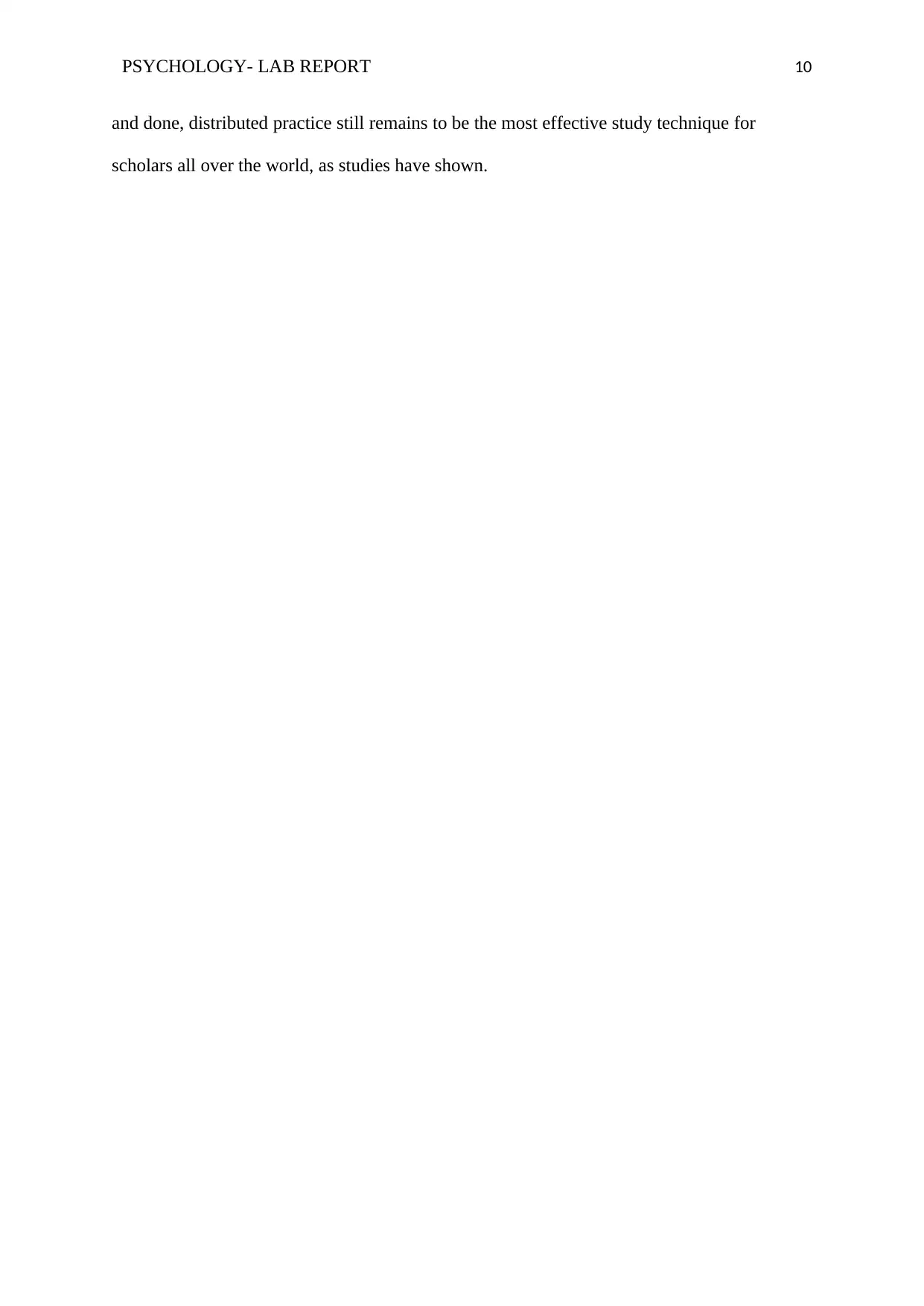
PSYCHOLOGY- LAB REPORT 10
and done, distributed practice still remains to be the most effective study technique for
scholars all over the world, as studies have shown.
and done, distributed practice still remains to be the most effective study technique for
scholars all over the world, as studies have shown.
Paraphrase This Document
Need a fresh take? Get an instant paraphrase of this document with our AI Paraphraser
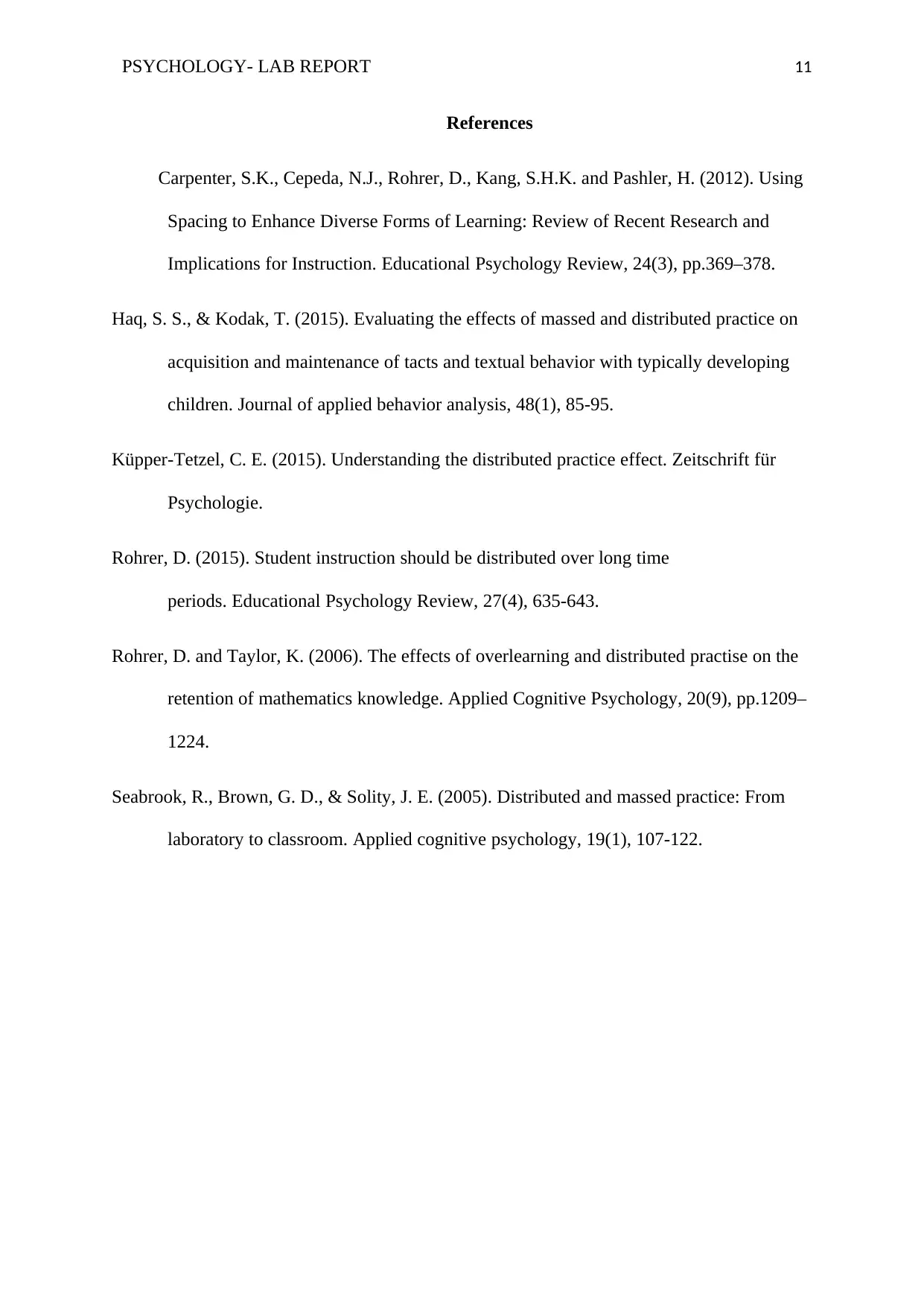
PSYCHOLOGY- LAB REPORT 11
References
Carpenter, S.K., Cepeda, N.J., Rohrer, D., Kang, S.H.K. and Pashler, H. (2012). Using
Spacing to Enhance Diverse Forms of Learning: Review of Recent Research and
Implications for Instruction. Educational Psychology Review, 24(3), pp.369–378.
Haq, S. S., & Kodak, T. (2015). Evaluating the effects of massed and distributed practice on
acquisition and maintenance of tacts and textual behavior with typically developing
children. Journal of applied behavior analysis, 48(1), 85-95.
Küpper-Tetzel, C. E. (2015). Understanding the distributed practice effect. Zeitschrift für
Psychologie.
Rohrer, D. (2015). Student instruction should be distributed over long time
periods. Educational Psychology Review, 27(4), 635-643.
Rohrer, D. and Taylor, K. (2006). The effects of overlearning and distributed practise on the
retention of mathematics knowledge. Applied Cognitive Psychology, 20(9), pp.1209–
1224.
Seabrook, R., Brown, G. D., & Solity, J. E. (2005). Distributed and massed practice: From
laboratory to classroom. Applied cognitive psychology, 19(1), 107-122.
References
Carpenter, S.K., Cepeda, N.J., Rohrer, D., Kang, S.H.K. and Pashler, H. (2012). Using
Spacing to Enhance Diverse Forms of Learning: Review of Recent Research and
Implications for Instruction. Educational Psychology Review, 24(3), pp.369–378.
Haq, S. S., & Kodak, T. (2015). Evaluating the effects of massed and distributed practice on
acquisition and maintenance of tacts and textual behavior with typically developing
children. Journal of applied behavior analysis, 48(1), 85-95.
Küpper-Tetzel, C. E. (2015). Understanding the distributed practice effect. Zeitschrift für
Psychologie.
Rohrer, D. (2015). Student instruction should be distributed over long time
periods. Educational Psychology Review, 27(4), 635-643.
Rohrer, D. and Taylor, K. (2006). The effects of overlearning and distributed practise on the
retention of mathematics knowledge. Applied Cognitive Psychology, 20(9), pp.1209–
1224.
Seabrook, R., Brown, G. D., & Solity, J. E. (2005). Distributed and massed practice: From
laboratory to classroom. Applied cognitive psychology, 19(1), 107-122.
1 out of 11
Related Documents
Your All-in-One AI-Powered Toolkit for Academic Success.
+13062052269
info@desklib.com
Available 24*7 on WhatsApp / Email
![[object Object]](/_next/static/media/star-bottom.7253800d.svg)
Unlock your academic potential
Copyright © 2020–2025 A2Z Services. All Rights Reserved. Developed and managed by ZUCOL.





